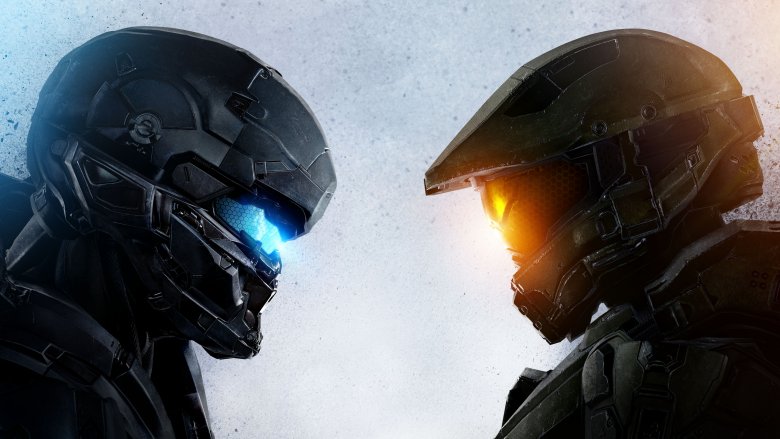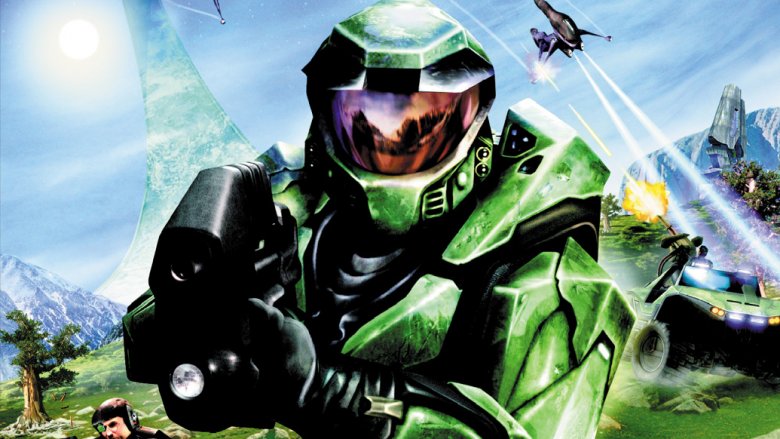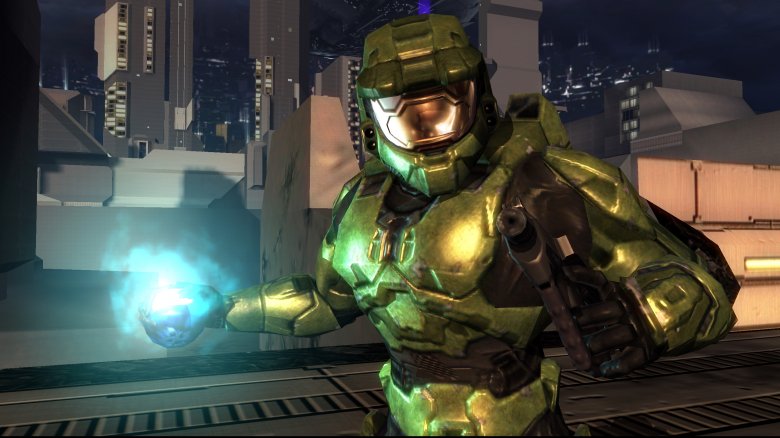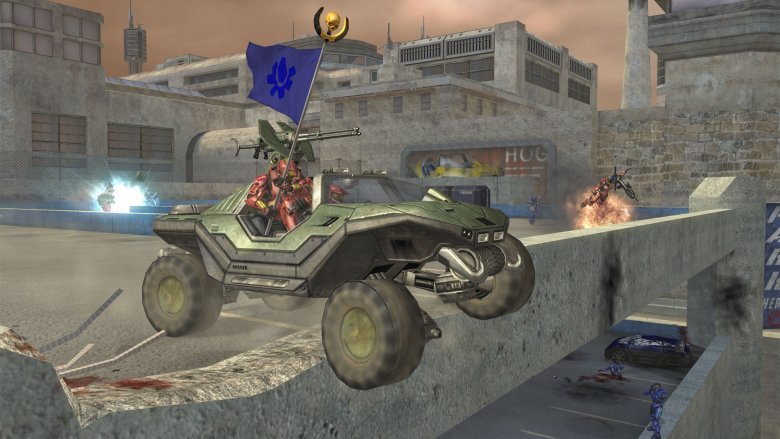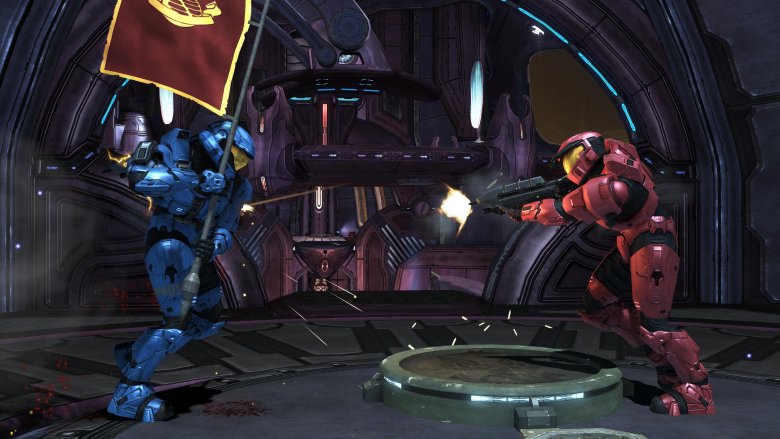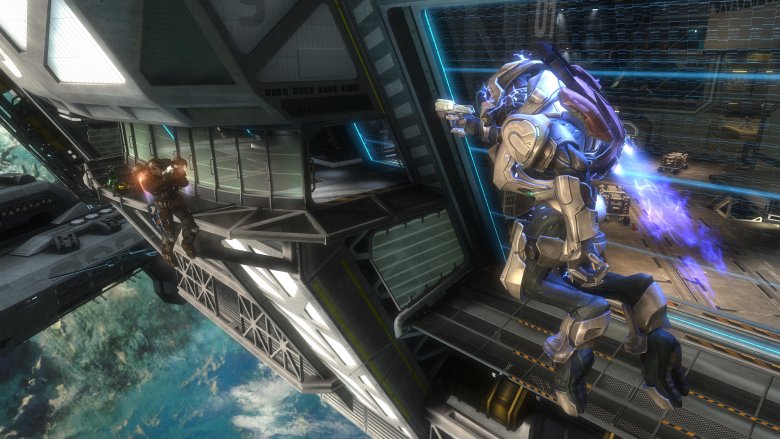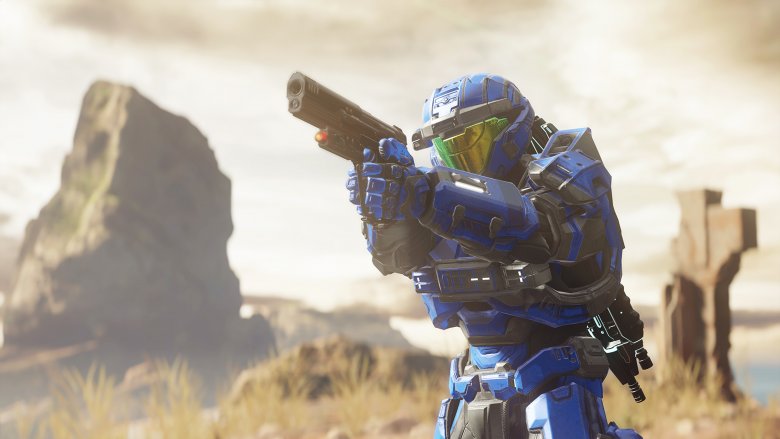The Untold Truth Of Halo
Today, the entire console ecosystem owes its shape to one franchise. Without Halo, Microsoft's Xbox would almost certainly never have hit the market with the impact it did, which paved the way for the later Xbox 360 and Xbox One. And for nearly a decade, Halo was the shooter that defined all others, the gold standard to which all others were compared. In fact, it's entirely possible that the shooter genre would never have gotten as big as it did without Halo's influence. That's the shadow that one franchise casts over the whole medium.
But did you know Halo was initially conceived as an exclusive for Microsoft's arch-rival? Or that the seminal classic of the shooter genre wasn't originally a shooter at all? For a series that everybody knows, its history has a lot of surprises buried inside. Its development took a lot of turns, even after the first game's release. And for all the success that developer Bungie found, they sometimes found expectations — and schedules — to be a curse. This is the backstory of the big man in the green armor, and the franchise he would lead for fifteen years and counting.
Halo was originally an RTS
In the 1990s, Bungie was a relatively small developer making games for the Mac. Their Myth series was a top-down real-time tactics game in which players control a large host of units with different abilities, and strategically position their troops to defeat overwhelming odds. Fast-paced yet deep, Myth: The Fallen Lords and Myth II: Soulblighter became standouts in the booming RTS genre, and successfully grew Bungie's fanbase to Windows PC users as well.
So if real-time tactics worked well for them, it only made sense to do it again. But instead of moving straight into Myth III, Bungie instead chose to start a whole new franchise: one based on science-fiction instead of fantasy. It would feature futuristic marines fighting bizarre aliens, involving both infantry and vehicles. Even the relatively grounded human design, with recognizable cars and infantry, looked instantly memorable.
But game development is a long and constantly-shifting process, so for whatever reason, Bungie chose to abandon the tactics genre and shift the fledgling Halo idea into the shooter realm instead. Specifically, the third-person shooter realm, complete with creatures on which the hero could ride. While this iteration, too, would be abandoned, the look of the hero was more or less locked in. The aesthetics of Halo seems to have been Bungie's guiding light at the time: they didn't know what the game was, but they knew it looked good. If they could make a game with that green armor in it, they'd have a hit on their hands. They were right.
Halo was a Mac exclusive
Eventually, Bungie signed a deal to make Halo exclusive to a major technology titan's platform, to prove that the system was a hardcore machine and to burnish its reputation as a gaming powerhouse. In other words, Apple made Halo a Mac exclusive. No, really!
Before Myth, Bungie had always developed exclusively for the Mac. One of their franchises had been Marathon, a futuristic first-person shooter series. The Marathon games had in fact been among the best Mac games available, and that wasn't lost on the Mac creators in Cupertino. So in the late '90s, when Steve Jobs returned to Apple and was trying to turn its declining image around, he reached out to Bungie to get them making excellent, ground-breaking, and technologically-advanced games exclusive to the Mac. At a time when Windows was the premier OS for gaming, Jobs wanted to break in.
None of this was lost on Microsoft, of course. While this was happening, the Seattle giant was creating its own video game console, which would eventually be the Xbox. Just like Apple, Microsoft wanted to prove the raw horsepower of their platform. Bungie had already given a demonstration of Halo on the Mac. How was Microsoft going to compete with that? Simple: they bought Bungie. Now that Microsoft owned the Halo developer, the Apple deal went away, and suddenly Halo was an Xbox exclusive. Imagine that.
Nobody knows if Microsoft did this just to stick it to Apple. But one wonders.
The legendary pistol was a last-minute tweak
Typically in shooters, the pistol is the weapon of last resort. You use it when your primary gun is out of ammo, and the enemy is so close that you don't have time to reload. So you whip out the puny pistol, do whatever damage you can, and hope you somehow take out the other guy in time. Otherwise, you never touch it.
As Halo: Combat Evolved neared its completion, its pistol was shaping up in much the same way. But Bungie co-founder and Halo game director Jason Jones didn't want the pistol relegated to second-class status, and personally tweaked the weapon's settings just weeks before the launch. He didn't run this by anybody: he just did it. It's good to be the boss! That tweak, he hoped, would make the pistol better.
Did he succeed? In a word: yes. A lot. The pistol from the original Halo is now the stuff of gaming legend, a hand-held cannon with a 2x scope that was basically the best all-around weapon in the game, and arguably, one of the best weapons in shooter history. Far from the back-up gun, the pistol effectively became the go-to weapon in most situations. Long-range, short-range, it didn't matter: the pistol was usually the right option.
Future games in the series tuned the pistol down a lot, so much that it basically did become the back-up gun that Jones feared. But the original gun had proved that sometimes, it's possible to fix something too well.
Halo solved the shooters-on-console problem
The first-person shooter genre was invented by id Software with Wolfenstein 3D and Doom, specifically for PCs. The keyboard-and-mouse setup was a natural fit for the emerging genre, particularly once full 360-degree tracking became possible.
Consoles, by contrast, only had a four-directional d-pad, which was too limiting for a full range of movement and sighting. Games like the original Medal of Honor tried to solve the problem by having the controller switch between movement and aiming at the press of a button. But this made for a "stop-and-go" type of shooter that wasn't in keeping with the fluid design of PC games.
Enter Halo: Combat Evolved. Both Sony and Microsoft had established dual analogue sticks on their controllers, but it was the Xbox release title that figured out how to make them work for the FPS genre. The left stick was for movement, and the right stick was for aiming. Once players figured out how to do both at once, suddenly they could move and shoot as quickly and easily as they could on the PC. True PC die-hards will insist that the mouse remains the more precise instrument, but for most gamers, the controller was suddenly a viable way to play shooters on console.
Not only did this make Halo a standout game on its own, it opened the door for developers to co-develop shooters for both PC and console. This in turn lead to the massive shooter boom in the 2000s, which lead to later juggernauts like Call of Duty.
Bungie loved bees
Bungie always was a bit of a different developer, a studio run by creatives and not suits. This lead to great games, and some truly wacky — and inspired — marketing ideas. The most famous of all was I Love Bees, an alternate-reality game (ARG) that debuted along with the first trailer for Halo 2. If you watch the above trailer carefully, the text for the game's website briefly flashes to www.ilovebees.com at about the :44 second mark. This led anybody curious to a website ostensibly about beekeeping, but that was being 'hacked' by some unknown entity.
Ravenous fans devoured every last detail they could about this supposed 'hack,' and careful analysis revealed all kinds of clues. This in turn revealed GPS coordinates and times, which pointed players to pay phones, which would receive a mysterious call at the appointed time. Audio logs embedded on the website revealed a strange tale of an artificial intelligence trying to communicate with the outside world. In the final analysis, it didn't have all that much to do with Halo. But it was an incredible mystery on its own.
Given the popularity of the original Halo and the hype over the upcoming Halo 2, interest in I Love Bees skyrocketed into a cultural event. Even those who didn't play the ARG itself followed it, and news about it helped drive consumer awareness about the sequel into the stratosphere. Halo 2, to no one's surprise, was a massive commercial success. At least a little of that came from bees.
Halo 2 was never actually finished
Halo 2 was every bit the sequel that fans had hoped for: a blockbuster with fantastic graphics, tight controls, and a sprawling single-player campaign alongside an endlessly replayable multiplayer. It was also every bit the sequel Microsoft wanted: it sold really well, and what's more, it sold Xbox consoles. But as it turns out, it wasn't every bit the sequel that Bungie had set out to make.
Halo 2 ended up being a brutal game to actually develop. While Bungie was a veteran studio, it seemed they just couldn't find a way to complete the game on time. Eventually Bungie was forced to make a tough call: they had to scrap the entire second half of the campaign. Not only was this painful for the creatives, but it also forced the game into a cliffhanger ending, one of the most famous in gaming history: hero Master Chief, on his way to Earth for an epic final battle... that would have to wait for the sequel.
Did that cliffhanger actually help sell units of Halo 3? Is that cliffhanger a fundamental part of Halo 2's identity? Maybe. Maybe not. Either way, it was never the original intention of the designers. But the painful experience of Halo 2 taught Bungie a lot about how gaming development had evolved in the modern era, and by all accounts, future games at the studio have been much smoother — although Destiny had issues of its own.
Bungie.net was developed long before Halo
Perhaps Halo 2's most important development was bringing online matchmaking to consoles. Never before had it been so easy to log online either alone or with friends, find a game, and start playing. Halo 2 multiplayer became a staple gaming experience of the mid-2000s, and whatever expectations Bungie had, this exceeded them. The underlying system that managed the matchmaking process was called Bungie.net, and it was an innovation that changed the industry forever.
The thing is, however, that Bungie.net was far older than Halo 2. Bungie had actually created the Bungie.net matchmaking system for Myth: The Fallen Lords way back in 1997. This was a revelation at the time, and developer-run matchmaking would go on to become an industry standard in PC gaming. Sound familiar? That's exactly what Bungie.net did for consoles in 2004. Not content to revolutionize multiplayer on one platform, Bungie just did it again on another.
These days, most games don't have a separate name for their matchmaking system: it's just an embedded part of the game. The idea that a multiplayer game wouldn't have some form of developer-supported matchmaking is laughable in the modern era. It is, quite simply, a core part of the multiplayer gaming experience. Bungie led that trend, not once, but twice.
Halo 3 was eclipsed by Call of Duty 4
Coming into 2007, there was no doubt what the biggest shooter of the year would be: the much-anticipated Halo 3. Microsoft had a new console, the Xbox 360, and while Halo 3 would come two full years after the launch, it was expected to be the killer app for the system. Every other shooter would have to scramble to get out of the 800-pound gorilla's way.
Halo 3 was, indeed, a massive success, praised by critics and fans alike. But as the year ended, it wasn't the shooter everyone was buzzing about. Seemingly out of nowhere, gamers around the world were feeling the call of duty.
To be fair, Call of Duty and Call of Duty 2 had both been successful games in their own right, so Infinity Ward's sequel, Call of Duty 4: Modern Warfare was always expected to do well. But nobody could have predicted just how well.
Modern Warfare shifted the action into the present day, allowing gamers to play with night vision, special operations gear, and Black Hawk helicopters like no game before it. What's more, its multiplayer was blisteringly fast-paced, much faster than the more balletic gun battles of the Halo franchise. Plus, Call of Duty 4 innovated the use of RPG mechanics in a shooter multiplayer, such as leveling up and gaining new gear over time. It was, quite simply, a game-changer, the way Halo and Halo 2 had been. Big and bold as Halo 3 was, it just didn't have a major innovation to call its own. The year of 2007 belonged to Call of Duty.
Bungie left after Halo: Reach
With the tremendous success of the Halo trilogy, and the boost it gave to the Xbox brand as a whole, Microsoft's decision to purchase Bungie had never looked better than in 2007. That's why it was such a shock when, in October of that year — just a week after the release of Halo 3 – Bungie announced that it was splitting off from Microsoft and going independent again.
Most of the details behind this split have never been made public. Why did Microsoft agree to let Bungie go, when Bungie was a wholly-owned subsidiary? How much money was exchanged to make this happen? But one major question was answered right away: the rights to the Halo franchise would stay with Microsoft. Bungie would be going it alone.
That said, the newly-independent studio needed to get some cash in the door fast. They needed to start working on a project immediately. Meanwhile, Microsoft suddenly found itself in need of a developer for the next Halo game.
So guess what? Immediately after the divorce, Microsoft hired Bungie — now a third-party developer — to make a Halo game. The result was Halo: Reach in 2010, a prequel game that did not star the iconic Master Chief. The game was once again praised by critics and fans, and proved that no one made a shooter quite like Bungie.
But that game really did mark the true end of the relationship. After Reach, Bungie moved on to its own new franchise, eventually revealed as Destiny. It was up to Microsoft to figure out how to make the next Halo.
343 Industries kept a lot of Bungie's talent
By the end of Bungie's Halo career, the little developer had grown into one of the biggest in the industry. Many of the studio's talent had made their careers with Halo, and what's more, poured a lot of their hearts and passion into the franchise. Not all of them were ready to leave it behind. So when Microsoft did finally set up its new Halo-specific studio, 343 Industries, a lot of Bungie veterans jumped ship.
The most well-known of these Bungie veterans was Frank O'Connor, who had been Bungie's community spokesperson for years. Of all Bungie employees, O'Connor was the most directly involved with communicating with fans, and thus his departure to 343 made the biggest splash. But as it happened, O'Connor wouldn't just be handling fan engagement over at 343: he would now become the Franchise Development Director for the whole of the Halo intellectual property. Microsoft wisely kept Halo in the hands of those who knew it and loved it most, even when Bungie was gone.
343 has made several Halo games now, and is widely believed to be working on the next game, tentatively titled Halo 6, as of this writing. It's been a long time since combat evolved back in 2001, and an even longer time since Halo was an RTS for the Mac. But it's still with us today.

